
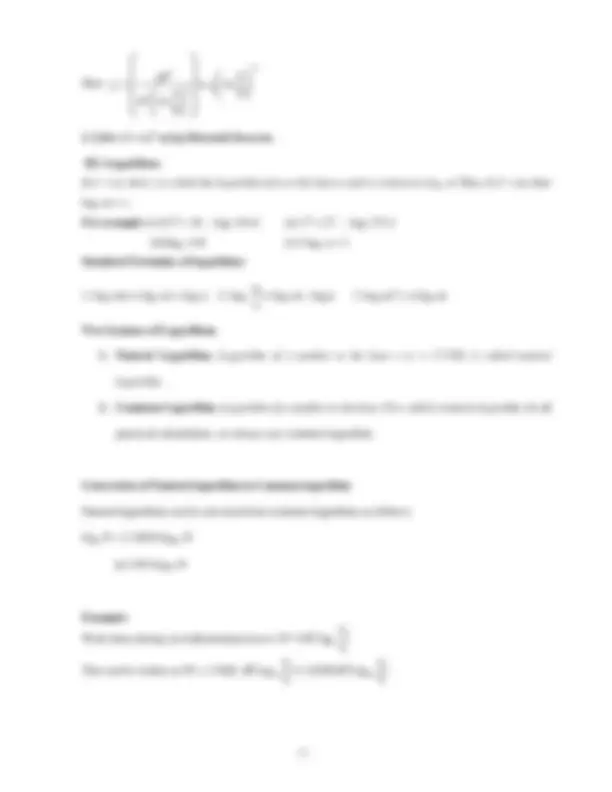
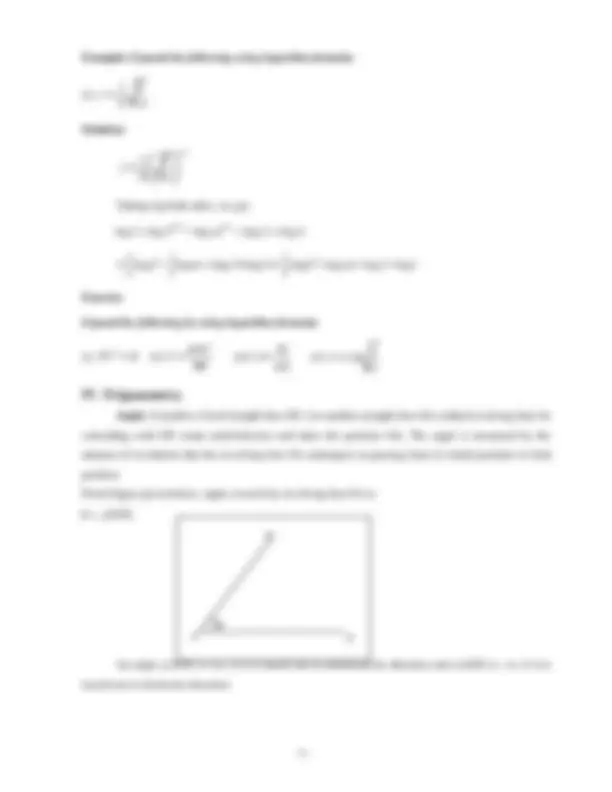
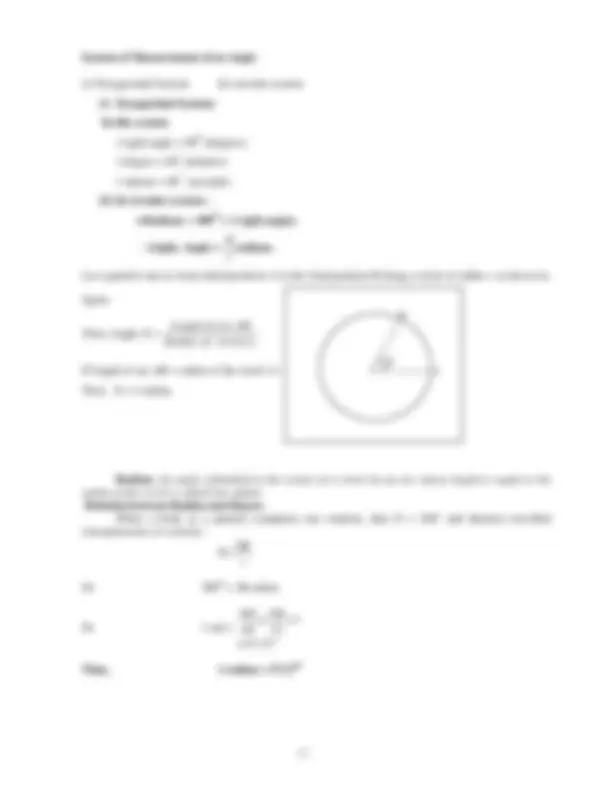
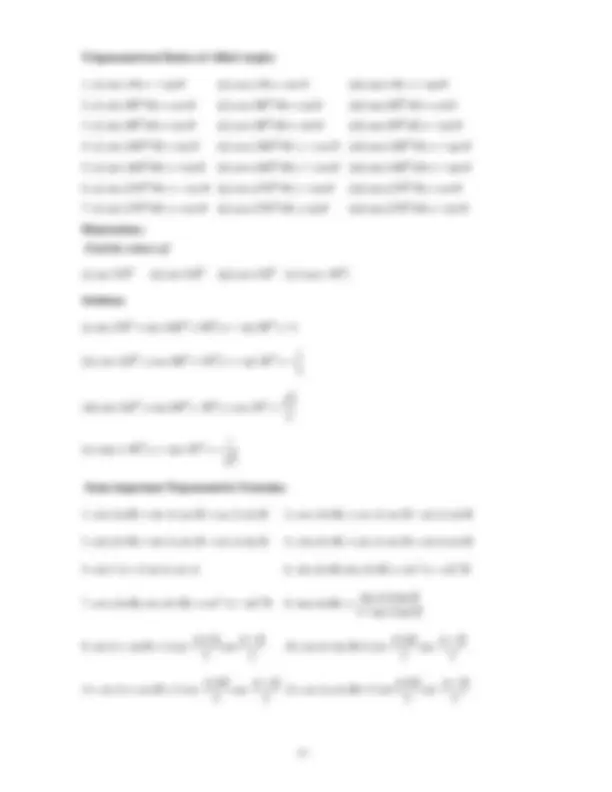
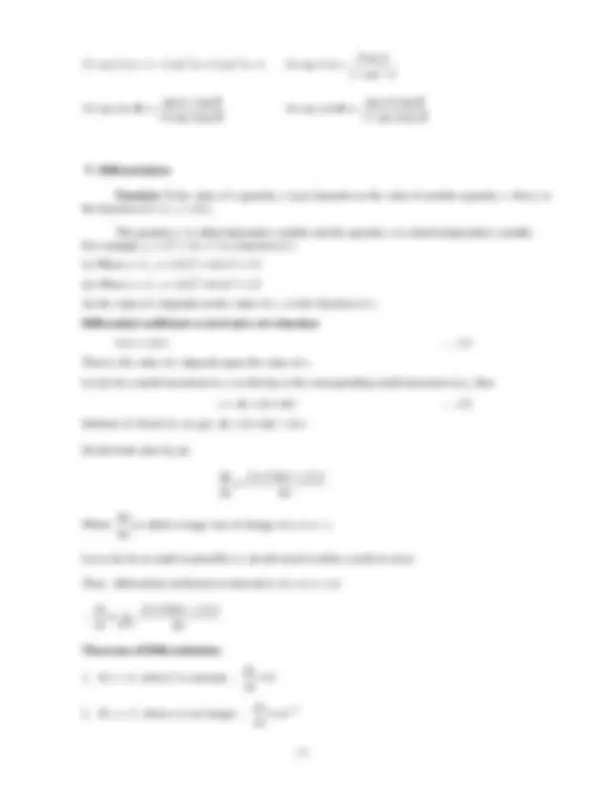
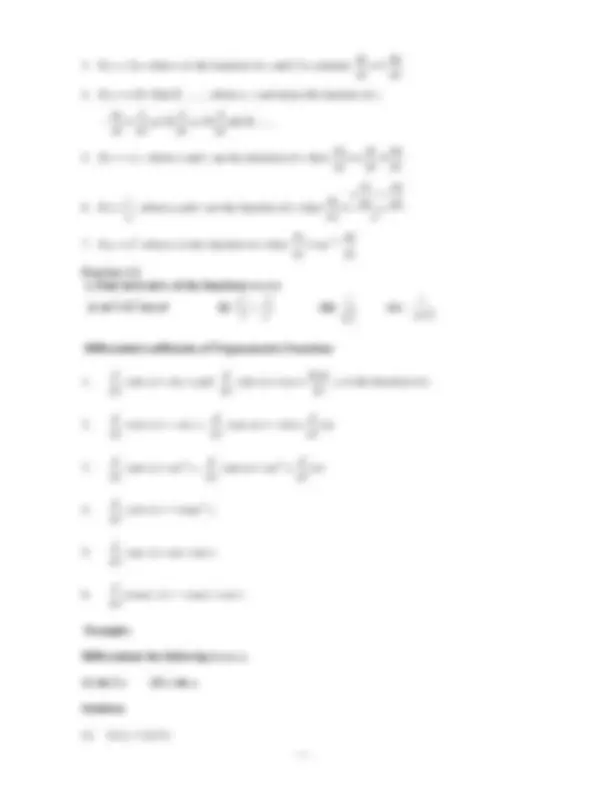
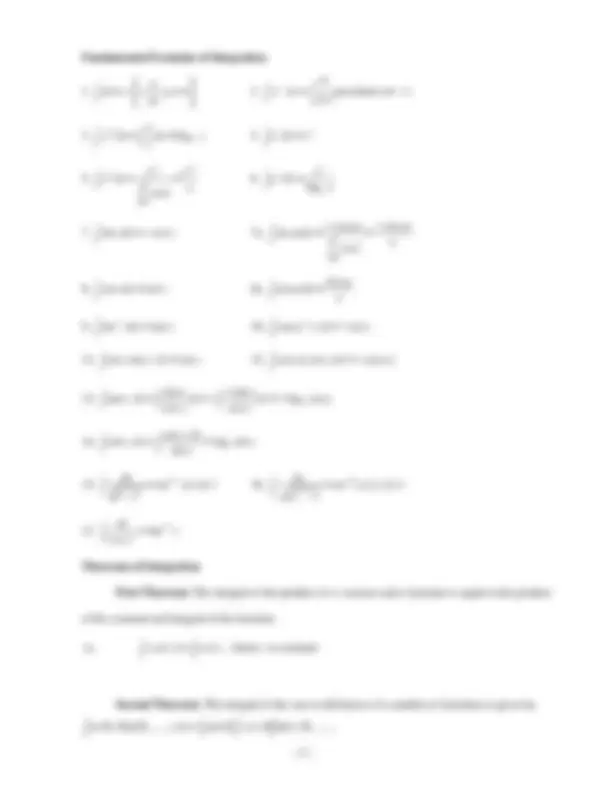
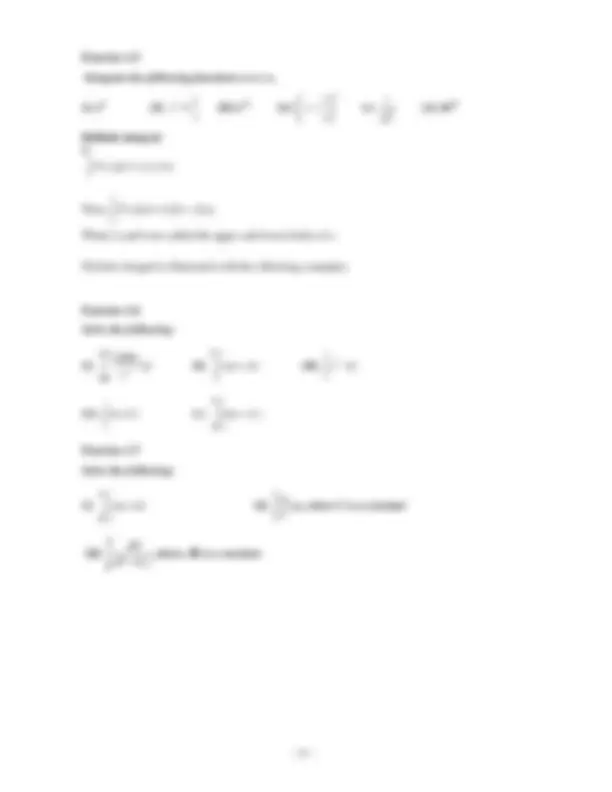
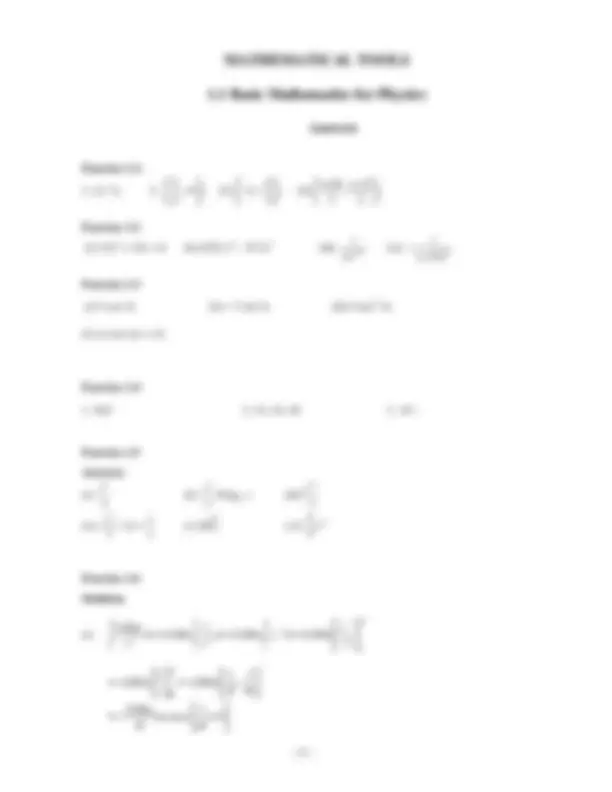


Study with the several resources on Docsity

Earn points by helping other students or get them with a premium plan


Prepare for your exams
Study with the several resources on Docsity

Earn points to download
Earn points by helping other students or get them with a premium plan
Community
Ask the community for help and clear up your study doubts
Discover the best universities in your country according to Docsity users
Free resources
Download our free guides on studying techniques, anxiety management strategies, and thesis advice from Docsity tutors
This book contains basic mathematics for physics
Typology: Study notes
1 / 16

This page cannot be seen from the preview
Don't miss anything!










Mathematics is the TOOL of Physics. A good knowledge and applications of fundamentals of
mathematics (which are used in physics) helps in understanding the physical phenomena and their
applications. The topics introduced in this chapter enable us to understand topics of first year pre
university physics.
I. Quadratic Equation and its Solution
A second degree equation is called quadratic equation.
The equation, ax
2
In this equation, a, b and c are constants and x is a variable quantity.
The solution of the quadratic equation is
2 4
b b ac x a
Illustration: Comparing the given quadratic equation x
2 — 5x + 6 = 0
with the standard form of quadratic equation a x
2 +b x + c = 0
We have a = 1, b = -5, c = 6
Now, we know
2 2 4 ( 5)^ ( 5)^4 1
b b ac x x a
x or
x or x
Exercise 1.1:
Solve for x comparing with the standard equation
1. x
2 − 9x + 14 = 0
2. 2 x
2
2
2
2
2 ) = 0
II. Binomial Theorem
According to this theorem,
n n n^ n n x nx x x
Where | x \ < 1, n is any negative integer or any fraction (positive or negative)
The total number of terms = n + 1 i.e. one more than the index of the power of the Binomial.
2! = 2 x 1, 3! = 3 x 2 x 1 and n! = n (n – 1) (n – 2) ( n – 3)..........
If |x| < <1, then the terms containing higher power of x can be neglected.
Therefore (1+ x )
n = 1 + nx****.
Binomial theorem for positive integral index
1 1 ( 1) 2 ( ) ..... 1! 2!
n n n n nx^ a^ n n^ x n x a x a a
− − −
where n is any positive integer.
Example 1: Expand (1+x)
-
Solution: (1+x)
x x x
= − x + x − x +
2 3 = 1 − 2 x + 3 x − 4 x +.....
Solution:
1/ 1/2 1/2 1 1/ 37 (36 1) (36) 1 5(1 0.028) 36
2 3
We have neglected the terms containing powers of 0.028.
6 1 [ 0.014] 6 1.014[ ]
Exercise:
1. The value of acceleration due to gravity (g) at a height h above the surface of earth is
2
2 ( )
gR g R h
If h<<R, then prove that g’ =
1 - 2h g R
Example: Expand the following using logarithm formulae
(i)
f l m
Solution:
1/ 1
f l m
Taking log both sides, we get
log f = log T
1/ − log m
1/ − (log 2 + log l )
log log (log 2 log ) (log log ) log 2 log. 2 2 2
= T − m − + l = T − m − − l
Exercise
Expand the following by using logarithm formulae
γ
l
Pr
4
= (iii) rpg
h
= (iv) (^2)
l T g
= π
IV. Trigonometry
Angle: Consider a fixed straight line OX. Let another straight line OA (called revolving line) be
coinciding with OX rotate anticlockwise and takes the position OA, The angle is measured by the
amount of revolution that the revolving line OA undergoes in passing from its initial position to final
position_._
From Figure given below, angle covered by revolving line OA is
An angle ∠AOX is +ve, if it is traced out in anticlockwise direction and ∠AOX is –ve, if it is
traced out in clockwise direction
A
θ
(^0) X
System of Measurement of an Angle
(i) Sexagesimal System (ii) circular system
(i) Sexagesimal System:
In this system
1 right angle = 90
O (degrees)
1 degree = 60
’ (minutes)
1 minute = 60
’’ (seconds)
(ii) In circular system :
π Radians = 180
O = 2 right angles
∴ 1right. Angle = 2
π radians.
Let a particle moves from initial position A to the final position B along a circle of radius r as shown in
figure.
Then, Angle, θ = Radiusof circle ( r )
LenghtofarcAB
If length of arc AB = radius of the circle ( r )
Then θ = 1 radian
Radian: An angle subtended at the centre of a circle by an arc whose length is equal to the
radius of the circle is called one radian.
Relation between Radian and Degree
When a body or a particle completes one rotation, then θ = 360° and distance travelled
(circumference of a circle).
θ = r
Or 360
O = 2π radian
Or 1 rad =
O
π
Thus, 1 radian = 57.
O
B
A
θ
Important relations:
2 θ+cos
2 θ = 1 5. sec
2 θ = 1 + tan
2 θ 6. cosec
2 θ = 1 + cot
2 θ
Signs of trigonometric ratios
The signs of various trigonometric ratios can be remembered from the above figure.
Trigonometric Ratios of Standard angles
The trigonometric ratios of standard angles are given in the following table:
Angle θ →
trig-ratio ↓
O 30
O 45
O 60
O 90
O 120
O 180
O
sin θ 0
cos θ 1
tan θ 0
Trigonometrical Ratios of Allied Angles
O −θ) = cos θ (ii) cos (
O −θ) = sin θ (iii) tan (
O −θ) = cot θ
O +θ) = cos θ (ii) cos (
O +θ) = sin θ (iii) tan (
O +θ) = −cot θ
O −θ) = sin θ (ii) cos (
O −θ) = − cos θ (iii) tan (
O −θ) = − tan θ
O +θ) = −sin θ (ii) cos (
O +θ) = − cos θ (iii) tan (
O +θ) = − tan θ
O −θ) = − cos θ (ii) cos (
O −θ) = −sin θ (iii) tan (
O −θ) = cot θ
O +θ) = −cos θ (ii) cos (
O +θ) = sin θ (iii) tan (
O +θ) = −cot θ
Illustrations:
Find the values of
(i) sin 270
O (ii) sin 120
O (iii) sin 120
O (iv) tan (-
O )
Solution:
(i) sin 270
O = sin (
O
O ) = − sin 90
O = − 1
(ii) cos 120
O = cos (
O
O ) = − sin 30
O = − 2
(iii) sin 120
O = sin (
O
O ) = cos 30
2
(iv) tan (− 30
O ) = − tan 30
O = − 3
Some important Trigonometric Formulae
2 A − sin
2 B
2 A − sin
2 B 8. tan (A+B) = A B
1 tan tan
tan tan
2
cos 2
sin 2
2
cos 2
sin 2
dx
du C dx
dx
d v dx
d u dx
d
dx
dy
dx
du
dx
dv u dx
dy = +
u
v , where u and v are the function of x , then 2 u
dx
du v dx
dv u
dx
dy
n , where u is the function of x then dx
du nu dx
Exercise 1.
1, Find derivative of the functions w.r.t x
(i) 4x
3 +7x
2 +6x+9 (ii) 2
5 5
(^2) x
x − (iii)^ x
(iv)
x + 4
Differential coefficients of Trigonometric Functions
d
dx
(sin x ) = cos x ; and
d
dx
(sin u ) = cos u
d u ( )
dx
, u is the function of x
d
dx
(cos x ) = − six x ;
d
dx
(cos u ) = − sin u ( )
d u dx
d
dx
(tan x ) = sec
2 x ;
d
dx
(tan u ) = sec
2 u
d
dx
( u )
d
dx
(cot x ) = − cosec
2 x
d
dx
(sec x ) = sec x tan x
d
dx
(cosec x ) = − cosec x cot x.
Example:
Differentiate the following w.r.t. x****.
(i) sin 2 x (ii) x sin x
Solution:
(i) Let y = sin 2 x
∴ (sin 2 ) cos 2 (2 ) cos 2 .2 2 cos 2
dy d d x x x x x dx dx dx
(ii) Let y = x sin x
∴ ( sin ) (sin ) sin ( ) cos sin.
dy d d d x x x x x x x x x dx dx dx dx
∴ cos sin
dy x x x dx
Exercise 1.
(i) sin 3 x (ii) cos 3 x
(iii) tan 4 x (iv) sin ( ax + b )
(v) cos (ax + b)
Differential Coefficients of Logarithmic and Exponential Functions
(log (^) e ) log e
d x e dx x x
(log (^) e ) ( )
d d u u dx u dx
d (^) u u d e e u dx dx
= 4. ( ) log
x x x e
d e e e e dx
d (^) u u d e e u dx dx
Example:
1. Differentiate the follow w.r.t .x.
(i)
2 (log (^) e x ) (ii) log( ax + b )
Solution:
(i) Let y =
2 (log (^) e x )
(log ) 2 log (log ) 2 log. log
dy d d x x x x x dx dx dx x x
(ii) Let y = log( ax + b )
log( ) ( ) ( )
dy d d a ax b ax b dx dx ax b dx ax b
Example 3: If
3 2
2s. S is measured in metre and t in second.
Fundamental Formulae of Integration
dx = x ⎥ ⎦
( x )= 1 dx
d Q 2.
1
n
x x dx
n n provided n ≠ − 1.
− dx x x
x dx log e
x x e dx e
ax ax ax e^ e e dx d (^) a ax dx
a
a a dx
e
x x
log
sin xdx = −cos x 7a.
a
ax
ax dx
d
ax axdx
cos
cos sin
cos xdx = sin x 8a.
a
ax axdx
sin cos
sec xdx = tan x
2
cos ec xdx = −cot x
2
sec x tan xdx = sec x 12.
cos ecx cot xdx = −cos ecx
= =− dx x x
x dx x
x x dx log e cos cos
sin
cos
sin tan
− sin ;| | 1
1
1
2
x x
x
dx
1
1
2
−
x x
x x
dx
−
2
Theorems of Integration
First Theorem: The integral of the product of a constant and a function is equal to the product
of the constant and integral of the function.
i. e. cudx = c udx , where c is constant.
Second Theorem: The integral of the sum or difference of a number of functions is given by
Exercise 1.
Integrate the following functions w.r.t .x,
(i) x
3 (ii) x
x
3x (iv)
2 1 ⎟ ⎠
x
x (v) x
(vi) 4e
5x
Definite integral
If
F ( ) x dx = f ( ) x + c
Then ( ) ( ) ( )
b
a
F x dx = f b − f a
Where a and b are called the upper and lower limits of x
Definite integral is illustrated with the following examples.
Exercise 1.
Solve the following:
(i)
=
=∞
x R
x
dx x
GMm
2
(ii)
/ 2
0
cos
π
x dx (iii)
2
1
3 x dx
(iv)
v
u
m v d v
(v)
−
/ 2
/ 2
sin
π
π
xd x
Exercise 1.
Solve the following:
(i)
−
/ 2
/ 2
cos
π
π
x dx (ii)
0
Q q dq C
where C is a constant
(iii)
θ
θ
1
d
(ii)
/ /.
0 cos^ [sin^ ]^0 sin^ sin 0^1 2
x dx x
π
(iii)
(^2 4 24 ) 3
(^1 )
x x dx
(iv)
2 2 2
2 2
v v^ v
u u (^) u
v v u m v d v m v d v m m
m v u
(v) cos( / 2 ) 0
2
sin [cos ] cos
/ 2
/ 2
/ 2 / (^2) ⎥= ⎦
−
− π
π
π
π
π xdx x π
Exercise 1.
(i) 2 (ii)
2
(iii)
1 0
2 0 log